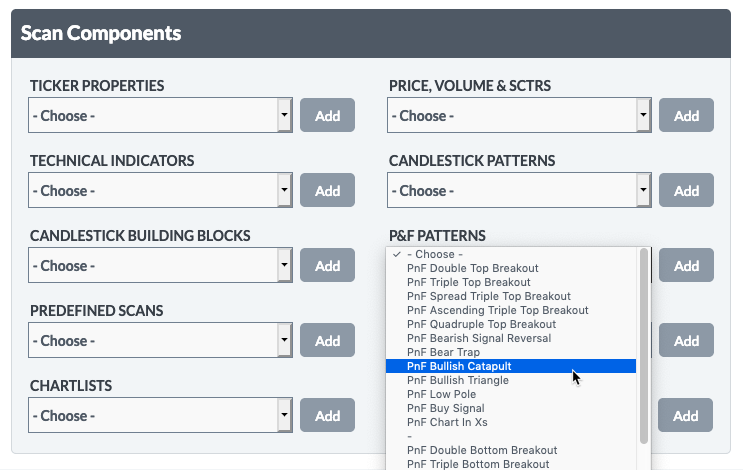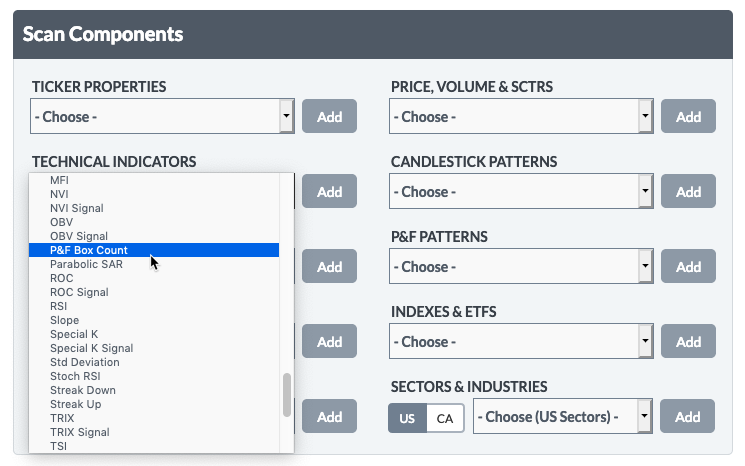Table of Contents
Writing P&F Scans
Whether or not our Scan Engine is able to scan for certain chart patterns is generally dependent on how well-defined the patterns are. Some chart patterns on regular bar/candlestick charts are very subjective, making them difficult for a computer to find - these patterns, consequently, are not supported on our Scan Engine. By contrast, P&F chart patterns, as we'll discuss below, are very easy for a computer to detect, as the relationship between the X's and O's for each pattern is quite well-defined. Consequently, the Scan Engine supports scanning for a wide range of P&F patterns.
Scanning for a P&F Chart Pattern
To scan for a P&F chart pattern in the Advanced Scan Workbench, simply select the desired pattern from the “P&F Patterns” menu in the Scan Components area, then click the “Add” button next to the menu.

All of these scan clauses use a format like this:
[PnF Bullish Catapult is true]
P&F Pattern clauses can be set to true or false. If set to true, this clause scans for stocks with a Bullish Catapult pattern. If set to false, it looks for stocks that are not having a Bullish Catapult pattern.
See our Scan Syntax Reference for details of the specific P&F chart pattern clauses available for scanning.
Scanning for P&F Signals
When scanning for stocks with a certain P&F pattern, it's important to understand that a stock may “have” a particular chart pattern for quite some time - weeks, months or even years. For example, if you scan for stocks where Bullish Catapult is true, you may see stocks in your results that have had the Bullish Catapult pattern for the past several days or weeks.
In most cases, you are only interested in stocks that have just started having a certain P&F Pattern today. To accomplish this, you need two scan clauses: one to check that the stock has the pattern today and one to check that it didn't have the pattern yesterday. For example:
[type is stock] and [PnF Bullish Catapult is true] and [yesterday's PnF Bullish Catapult is false]
This scan will only return stocks that started having the Bullish Catapult pattern today.
Scanning for P&F Box Count
In addition to P&F patterns, there is one more P&F-related scan clause available to you: P&F Box Count clauses scan for stocks that have a certain number of boxes in the current column on the P&F chart.
To add a P&F Box Count scan clause, select it from the “Technical Indicators” menu in the Scan Components area of the workbench, then click the “Add” button next to the menu.

This scan clause uses a format like the one show below to check the number of boxes in the current column of the P&F chart:
[P&F Box Count > 10]
The example above scans for stocks that have more than ten boxes in their current column, whether X's or O's. If you want to ensure that the current column has more than 10 X's, you would combine two clauses - one to check the number of boxes, boxes, the other to check that the current column is a rising column of X's:
[type is stock] and [P&F Box Count > 10] and [PnF Chart In Xs is true]
This scan will only return stocks that have more than 10 X's in their current column.
Chart Scaling in P&F Scans
Our Scan Engine uses only traditional scaling with a 3-box reversal when determining which stocks meet the criteria for your P&F-based scans. You cannot scan for P&F patterns using other scaling methods or reversal settings.
Learn More: P&F Scaling and Timeframes
Conclusions
Some bar/candlestick chart patterns are not available in our Scan Engine, but P&F patterns can be a good alternative for use in your scans. To learn more about the P&F chart patterns available and what they indicate, please check out our P&F Pattern Alerts article in ChartSchool.